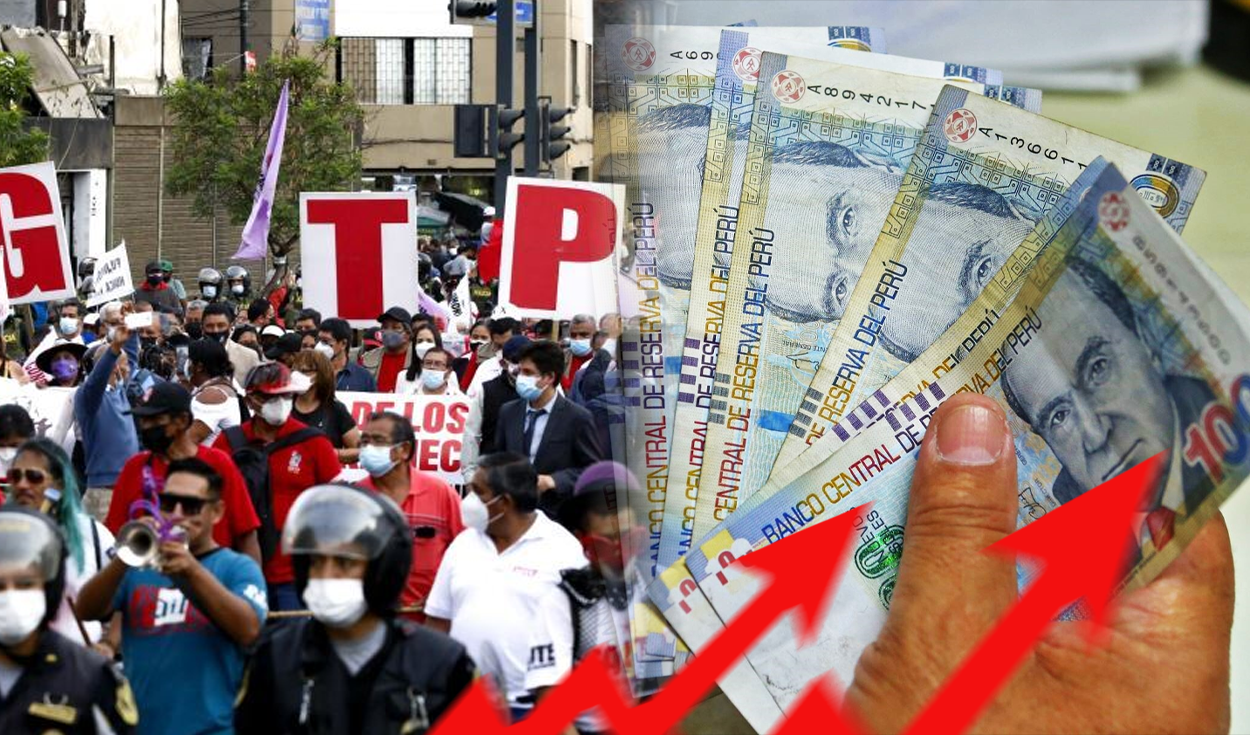
During the last 20 years, the minimum living wage in our country has been increased 11 times by the governments in power. However, the amount of S/1,025 that workers receive has suffered a large devaluation and is not enough to cover the basic family basket, which today is subject to price variability in different items, according to the various worker unions.
In this way, the General Confederation of Workers of Peru (CGTP) announced a national mobilization that will take place on Wednesday, February 21, to demand that the Government of Dina Boluarte adjust the minimum vital remuneration, which must be reincorporated into the debate agenda. of the next sessions of the National Labor Council.
Minimum salary: how much is the increase proposed by the unions?
In statements to La República, Gerónimo López, general secretary of the General Confederation of Workers of Peru, maintained that the increase in the minimum living wage must be progressive until it reaches the amount of the basic family basket. “We believe that the minimum wage should be increased now to S/1,500 so that it progressively reaches the ceiling, which is S/2,200 or S/2,300.”
For López, one of the reasons that justify the increase in the RMV (Minimum Living Remuneration) is the promotion of domestic consumption that would facilitate the country’s economic reactivation process. “The Government has to understand that you can no longer live with S / 1,025. In the midst of this economic recession, it is necessary to promote public and private investment, as well as the increase in the minimum wage,” he said.
For his part, Julio César Bazán, from the Unitary Central of Workers of Peru (CUT), indicated that there are a series of factors for the gradual increase of S/1,025, such as the increase in the basic family basket, reducing the existing gap compared to the minimum wage and the need to recover purchasing power.
Along these lines, he explained that the proposal of his union is the establishment of a schedule of increases that in a first tranche reaches S/1,500 and the application of a proration so that in five years it reaches the value of the basic family basket. According to the INEI, the basic family basket, which includes food, services and basic needs, amounts to S/1,660, considering figures from 2022.
Why is the debate on the increase in the minimum wage not moving forward in the National Labor Council?
During his latest statements to the media, the Minister of Labor and Employment Promotion, Daniel Maurate, recalled that there is a commitment from the Government of Dina Boluarte to raise the minimum vital remuneration. However, this important issue has not been able to achieve consensus among the members of the National Labor Council, a space that brings together the State, business associations and union centers.
For Julio César Bazán of the CUT, this body that discusses the country’s labor policies does not have binding resolution mechanisms and argues that its operation was blocked by the withdrawal of the business sector during the past year. Until this moment, Minister Maurate convened an extraordinary session on January 17 in which issues related to the improvement of its institutions, productivity and the fight against informality were addressed.
According to Gerónimo López, in 2007 a technical review mechanism for the minimum wage was approved by the National Labor Council, which proposes a formula to calculate possible increases in the RMV based on inflation and productivity. However, this proposal has not been implemented due to a lack of political will on the part of the Government.
“The National Labor Council is just a formality because we have not been able to reach an agreement with the employers. We must remember that the ILO clearly indicated that the Technical Commission is in charge of evaluating the increase in the minimum wage each year. However, This is not going well and depends on the political action of the Government,” he said.
What did the Minister of Labor say about the increase in the minimum living wage?
A few days ago, the Minister of Labor, Daniel Maurate, gave some statements to the press in which he recalled the presidential commitment to increase the minimum living wage. Likewise, he expressed his confidence that the Peruvian economy will recover in 2024, which will generate a favorable scenario to restart the discussion of this issue in the National Labor Council.
“We did not do it last year because the economy entered a recession, and in a recession situation it is not advisable to increase the minimum wage. The outlook is very favorable for this year. Hopefully we will have that announcement by July 28 (National Holidays), but it depends on how the economic recovery goes.”, he said.
Which government increased the minimum wage the most in the last 20 years?
Throughout our history, the presidents of Peru have issued various legal devices to increase the minimum wage and, in this way, improve the living conditions of the population. From 2003 to the present, the RMV has increased by S/615. In this regard, the Government of Ollanta Humala was the one that increased this amount the most in the last 20 years, since this income progressively went from S/600 to S/850, which is equivalent to 41.67%.
In second place is the management of former president Alejandro Toledo, who increased the RMV twice, whose value went from S/410 to S/500, which means a variation of 21.95%. Then comes Alan García, who made the increase in the minimum wage official on up to four occasions, going from S/500 to S/600, which is equivalent to 20%.
Source: Larepublica
Alia is a professional author and journalist, working at 247 news agency. She writes on various topics from economy news to general interest pieces, providing readers with relevant and informative content. With years of experience, she brings a unique perspective and in-depth analysis to her work.












